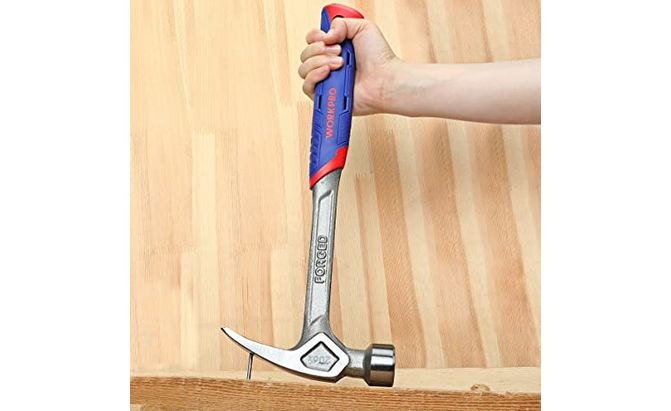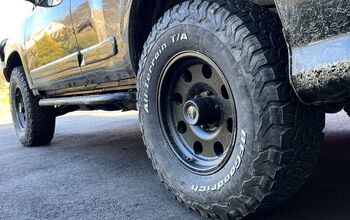The Best Hammer to Complete Your Tool Kit

Not all hammers are created equal—at least according to Thor. Whether you’re a Norse God or a simple art lover hanging a picture over the fireplace, a quality hammer is essential—the best hammers offer power, precision, and ease of use.
There are different hammers, each of which is better suited to a given task. Sledgehammers are built to deliver a forceful blow; with heavy heads and robust handles, they power through demolition jobs and knock down walls or break up paving. Claw hammers are more multipurpose, with lightweight construction, modestly heavy head, and a soft rubber grip. The “claw” behind the head allows you to remove the inevitable crookedly-driven nail.
Other hammers and mallets are more specialized. A soft-faced mallet or dead blow hammer tempers the blunt force of a hammer blow to drive softer objects home without breaking them; they’re great for things like tiling and flooring or installing trim on automotive panels. A hammer with a malleable brass head delivers more force than a dead blow hammer or rubber mallet but is more forgiving than rigid steel or titanium-headed hammers; use them for dislodging cylinder heads or suspension components after the retaining bolts are removed. Then there are safety hammers for breaking glass, peen hammers for shaping materials, and general household hammers.
Good hammers are affordable, so it makes sense to have a selection of different types to hand so you can tackle any chore in the home or garage.
Here are some of the best hammers to have in your toolbox.
Table of contents
- 1. Editor’s Pick: Irwin 16-ounce General-Purpose Claw Hammer
- 2. Best Mallet: C&T Black Rubber Mallet Hammer and Double-Faced Soft Hammer Set
- 3. Best Heavy-Duty Claw Hammer: Workpro Claw Hammer
- 4. Best Brass Hammer: Tekton 16-ounce Jacketed Fiberglass Brass Hammer
- 5. Best for Metal Shaping: KSEIBI Cross Pein Engineers Hammer
- 6. Best Dead Blow Hammer: Neiko 2-pound Dead Blow Hammer
- How to Choose a Hammer
1. Editor’s Pick: Irwin 16-ounce General-Purpose Claw Hammer
This 16-ounce claw hammer from Irwin is an affordable and durable general-purpose hammer for your home featuring a lightweight and shock-proof fiberglass handle, metal head, and an ergonomic grip. The curved handle base prevents the handle from slipping through your hands as you swing, and the textured handle makes it easier to grip for better precision.
Hammers with two-piece construction (as opposed to being forged or cast in one piece) tend to be best for light to moderate household duties. The head of this design can work free over time. This hammer has a soft face, so it’s not good for hitting sharp or hard steels as they’ll dent or degrade the face.
We like the claw because it’s not as aggressively angled as some, so you can get underneath nails more easily and with less room to pivot the head. The other big plus for Irwin’s 16-ounce hammer is its surprisingly low price.
Key Features
Type: Claw hammer
Weight: 1.54 pounds
Handle Length: 12.75 inches
Material: Alloy steel head, fiberglass handle
Pros | Versatile, affordable |
Cons | Not a heavy-duty tool, prone to leaving marks |
2. Best Mallet: C&T Black Rubber Mallet Hammer and Double-Faced Soft Hammer Set
The only thing better than one hammer is two. At least that’s the C&T approach to softer hammers and mallets. This affordable two-pack includes a conventional rubber mallet with a 1.4-inch face. That large flat face makes for good accuracy and also helps distribute force across a large area to protect fragile objects like tiles or vinyl plank flooring.
The smaller hammer features two different faces, one slightly harder than the other, which makes it more versatile. Both hammers feature a fiberglass handle wrapped in TPR rubber, and the head is connected to the handle with a proprietary “embedded process” the company says is superior to traditional joining methods. Both handles are contoured to prevent slippage, with a curved base that stops your hand from sliding off the end.
These are well-made, affordable, and versatile options for delicate hammering tasks.
Key Features
Type: Rubber mallet/double-faced soft hammer
Weight: 16 ounces
Handle Length: 12.75 inches
Material: Fiberglass handle, rubber, and fiberglass head
Pros | Won't leave marks, ideal for more-delicate surfaces |
Cons | Light weight, strong rebound action |
3. Best Heavy-Duty Claw Hammer: Workpro Claw Hammer
Workpro’s heavy-duty, 20-ounce claw hammer is forged from one piece of steel alloy for maximum durability. Its substantial weight makes for powerful nail driving, and there’s even a magnetic nail holder on the top which allows you to set nails one-handed.
We like the AirTech rubber handle which cushions blows for your hands using a clever system of air pockets and rubber. Despite its quality construction and clever features, this Workpro hammer is competitively priced making it a compelling option for professionals and do-it-yourselfers alike.
It’s worth noting that a 20-ounce hammer is larger and heftier than your average household hammer, so be aware of that if you’re new to heavy-duty hammers. We like the aggressive claws that allow you to easily remove even the most stubborn of nails, and the sharp edges on them that allow you to pry boards and wood plans apart.
Workpro’s handle is clever and contoured for grip, but the small anti-slip curve at the bottom is more conservative and less effective than most. That won’t affect most users though, and this is a high-quality, heavy-duty hammer designed for everyday use.
Key Features
Type: Claw hammer
Weight: 20 ounces
Handle Length: 15.97 inches
Material: One-piece forged steel, rubber handle
Pros | Extremely durable, one-handed nail setting |
Cons | Bigger than standard claw hammer, can be harder to grip |
4. Best Brass Hammer: Tekton 16-ounce Jacketed Fiberglass Brass Hammer
This soft-faced hammer from Tekton allows you to strike various materials without causing damage or creating sparks because the malleable brass head deforms slightly on impact. It's great for automotive and garage applications, especially working with delicate materials.
It's also suitable for striking hole punches, metal stamps, or peening tools to shape and mark metals.
The handle is fiberglass coasted in impact-resistant poly material for comfort. The manufacturer says the head is bonded to the handle with a non-loosening epoxy—though some users reported heads loosening. The handle is a short 11 inches, and the small 1.1-inch diameter head is for precision striking, not heft. Long-story-short: This is an excellent hammer for detailed and delicate work.
Key Features
Type: Brass hammer
Weight: 16 ounces
Handle Length: 11 inches
Material: Poly-coated fiberglass handle, brass head
Pros | Precision tool, competitive price, non-sparking |
Cons | Light weight, some users reported head loosening in spite of manufacturer's claim |
5. Best for Metal Shaping: KSEIBI Cross Pein Engineers Hammer
This cross-pein (more commonly spelled peen) engineer’s hammer from KSEIBI features a round face and a wedge pein perfect for shaping metals in the home or garage. The fiberglass handle is jacketed in a rubber grip and offers excellent impact absorption with no recoil, which allows the user to strike metal repeatedly without fatiguing.
There are three sizes available, 1.1, 2.2, and 4.4 pounds. We like the smallest 1.1-pound option for its lightness and ease of use; especially for more delicate shaping tasks. The carbon-steel head is soft enough to protect the surfaces you’re striking and not mark them but is prone to taking on marks.
Some users report that the head can work loose from the fiberglass handle. But most users praised this hammer for its comfort, precision, and affordable price.
Key Features
Type: Cross-pein hammer
Weight: 1.1 pounds
Handle Length: 13 inches
Material: Poly-coated fiberglass handle, carbon-steel head
Pros | Versatile shaping hammer, comfortable handle |
Cons | Head can loosen under extreme conditions, hammer's face can become marked |
6. Best Dead Blow Hammer: Neiko 2-pound Dead Blow Hammer
Much like a rubber mallet or brass hammer, a dead blow hammer is designed to absorb some of the force of a hammer blow to avoid damaging the object being struck. It accomplishes this by using a head filled loosely with shot or other material, which acts to subdue rebound. Besides a more controlled impact, the surface of this dead blow hammer is plastic so that it won't create sparks.
Neiko's 2-pound dead blow hammer is molded from day-glow orange plastic and features crosshatching on the handle for better grip. Besides automotive work, a dead blow hammer is handy for household repairs, woodwork, flooring, and other chores.
A dead blow hammer will probably not be the first tool you reach for, but they're good to have around when the need arises—besides, they're not expensive.
Type: Dead blow hammer
Weight: 2 pounds
Handle Length: 13 inches
Material: Plastic and steel
Pros | Affordable, rebound-resistant, won't spark |
Cons | Soft plastic can scar and discolor |
How to Choose a Hammer
The right type of hammer for your home or garage depends largely on the sort of work you’ll be doing, and how often you’ll do it. If you’re looking for a general-purpose hammer then a claw hammer is often your best bet. It allows you to remove nails, pry wood and other trim apart, and drive fasteners home with ease.
A peen hammer, whether it’s a ball peen or wedge peen allows you to shape metal. Many cheaper household hammers feature a regular flat face on one side and a ball-peen on the other. We recommend claw hammers instead as they’re more versatile and better suited to most home tasks.
What Hammer Weight is Best?
Claw hammers for general use are usually available in 8, 16, or 20-ounce variants. You should choose an option that allows you to swing smoothly and accurately without fatigue. An 8oz hammer will have enough force to drive a picture hook into a wall but may struggle to drive nails for harder wood surfaces. Meanwhile, a 20-ounce hammer is overkill for light duty.
Another consideration is handle length. A longer handle allows more force to be imparted on the object you’re striking, while a shorter handle makes for better control. In most instances, a 12-inch long, 16-ounce hammer is a good balance between all of these considerations.

Bryan is just as likely to have a bone china teacup in his hand as a torque wrench, and he loves cars-especially old and sometimes unpopular ones. He shares this enthusiasm through Malaise Motors, the Facebook group he founded, and by contributing to publications such as Old Cars Weekly, Crankshaft, Forbes, and others. Bryan Fun fact: he is psychically attuned to the distinct electrical frequencies emanated by Lucas ignition systems.
More by Bryan Raab Davis
































Comments
Join the conversation